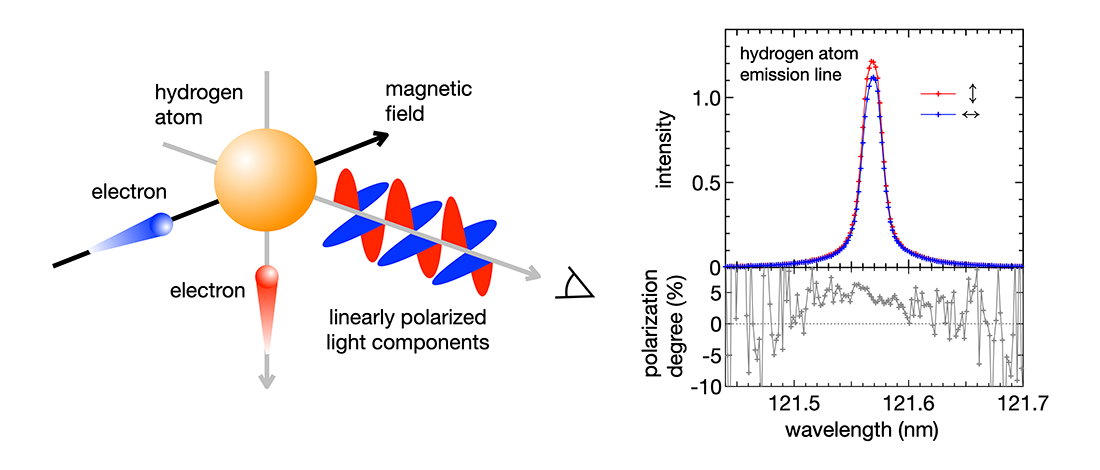World's First Detection of Anisotropy in Electron Motion by Spectroscopic Measurement
In the Large Helical Device (LHD), the polarization of light emitted by hydrogen atoms has been measured with an accuracy of 1%. The analysis of the polarization angle showed that the motion perpendicular to the magnetic field is more dominant than that parallel to the magnetic field for electrons at the plasma edge, which supports our intuitive understanding of the plasma condition in that region.

In the Large Helical Device (LHD), the polarization of light emitted by hydrogen atoms has been measured with an accuracy of 1%. The analysis of the polarization angle showed that the motion perpendicular to the magnetic field is more dominant than that parallel to the magnetic field for electrons at the plasma edge, which supports our intuitive understanding of the plasma condition in that region.
The plasma of the Large Helical Device (LHD) is confined by a magnetic field. The motion of electrons in the plasma can be divided into two components: the translation velocity in the magnetic field direction and the rotation velocity in the plane perpendicular to the magnetic field direction. Electrons with a large velocity component moving in the magnetic field direction will continue to move along the magnetic field lines, while particles with a large rotational velocity component will tend to be trapped in regions with low magnetic field strength which varies along the magnetic field lines.
Electrons in the plasma edge, when flung out of the confinement region due to collisions with other particles, are guided along the magnetic field lines to the vessel wall and are lost, while electrons with a large rotational velocity component tend to stay in the plasma for the reasons mentioned above. It has been therefore pointed out that the directional distribution of electron motion outside the confinement region may be anisotropic. This anisotropy in electron motion affects the ionization rate of the atoms which influences the plasma production characteristics and is also thought to be involved in the formation of the electric field that determines the confinement performance of the plasma.
A possible clue for understanding the anisotropy of electron motion is the light emitted by atoms or ions in the plasma. When an atom collides with an electron, it receives a portion of the electron's kinetic energy and transitions to a higher energy state. Since the high energy state is unstable, it returns to its original low energy state after a short period of time (typically about a nanosecond), and the difference in energy is emitted as light.
Light is a kind of electromagnetic wave. Electromagnetic waves oscillate in a direction perpendicular to their direction of motion. The azimuthal angle of oscillation is arbitrary, and most of the light we see in our daily lives is a mixture of waves oscillating at various azimuthal angles to the same degree. However, there are some cases where the intensity of the waves differs depending on the azimuth angle. Such light is called "polarized".
The azimuthal angle of the light oscillation coming out of an atom colliding with an electron is affected by the direction of the colliding electron's motion (see figure). At the LHD, we are studying the magnitude of the polarization of the light emitted by hydrogen atoms to determine the anisotropy of the electron motion in the plasma.
In the LHD and other plasmas aimed at nuclear fusion, the expected polarization degree is so small that it is necessary to detect a difference in light intensity of about 1%. Based on the hints obtained in the joint research with the Solar Observation Group of the National Astronomical Observatory of Japan (NAOJ), and after several years of development of measurement instruments, we have finally succeeded in realizing high-precision polarization measurement at the LHD and actually detected the polarization. It was confirmed that the polarization of the emission lines occurs between the direction of the magnetic field and the direction perpendicular to it, and initial analysis showed that electrons moving perpendicular to the magnetic field, i.e., rotating electrons, have dominant distribution characteristics.
The research was carried out by a research group led by Nilam Ramaiah, a student at the Department of Fusion Science at the Graduate University for Advanced Studies, and Motoshi Goto at the National Institute for Fusion Science.
The results of this research were published on November 12, 2020 in Journal of Quantitative Spectroscopy and Radiative Transfer, a journal on spectroscopy.
